The best hikes in Europe take you through the high passes of the Swiss Alps and around the dramatic volcanic coastlines of the Canary Islands. They lead you through the boreal forests and glaciers of Sweden, and across the windswept highlands of Scotland.
Europe is made up of over 40 countries and each boasts its own unique culture, as well as a distinct and diverse landscape. Add in its 10 major mountain ranges and 504 national parks, and you've got a whole lot of hiking territory to explore.
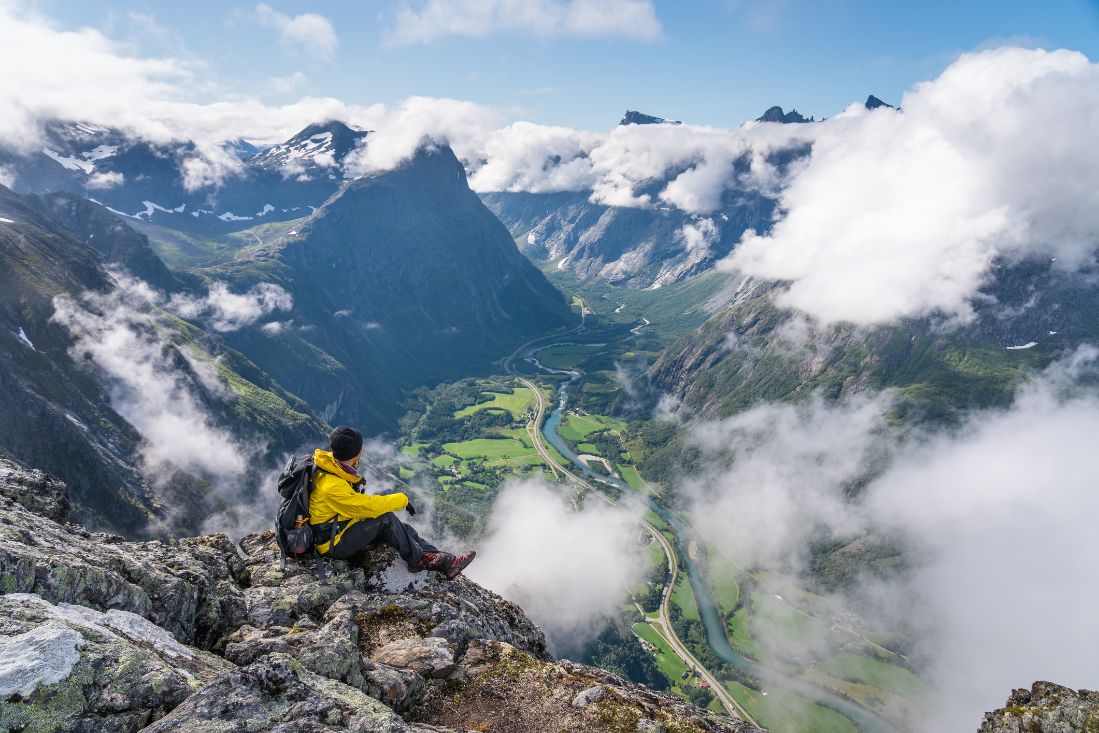
Here at Much Better Adventures, we've done the hard work for you and come up with a list of the 20 best treks in Europe. For us, 'best' is something that's going to show you breathtaking scenery, take you off the beaten track, and challenge you in the best possible way. We also wanted to showcase some of the diverse landscape of the continent, and open your eyes to some countries you might have not considered exploring. These are our top 20 picks:
- The Spaghetti Tour of Monte Rosa (Italy)
- The Peaks of the Balkans Circuit (Albania, Kosovo, Montenegro and North Macedonia)
- The Vindios Loop in the Picos de Europa (Spain)
- The Madeira Coast to Coast Trek (Portugal)
- Tour de Mont Blanc (France)
- The Selvaggio Blu Trail (Sardinia)
- Mount Triglav (Slovenia)
- The Transcaucasian Trail (Georgia)
- The West Highland Way (Scotland)
- Gran Canaria Traverse (Spain)
- The Laugavegur Trek (Iceland)
- Haute Route (France, Switzerland)
- Tatranská Magistrala (Slovakia)
- The Dolomites' Alta Via (Italy)
- The Albanian Coastal Trail (Albania)
- Gran Paradiso Hut to Hut Trail (Italy)
- Kungsleden (Sweden)
- The Matterhorn Circuit (Switzerland)
- Vikos Gorge (Greece)
- The Welsh 15 Peak Challenge (Wales)
It’s important to note that these route descriptions are only short summaries, designed to inspire but not to serve any navigational purpose. They are not intended to guide you on the route and further mapping and planning (or a local guide!) will be required if you want to safely walk any of the trails featured. This is particularly important in mountainous environments such as the Alps.
Here’s our guide to the best hiking in Europe, what time of year to plan a trip, and where to stay.
The Best Hikes in Europe, Mapped
This map shows the start points for all the hikes listed in this guide, organised into difficulty level. You'll see that the majority of them are challenging - that's because we love a bit of type two fun!
The Best Multi-Day Hikes in Europe
1. The Spaghetti Tour of Monte Rosa, Italy

- Start/Finish: Cervinia/Gressony
- Distance: 15.5 miles (25km) - 24.8 miles (4okm)
- Duration: 4-6 days
- Difficulty: Challenging
- Best for: Summit bagging in the Alps
Monte Rosa (4554m), a massif on the border of Switzerland and Italy, is a huge chunk of a mountain. It contains the most land over 4000m in the alps, and it has 18 true peaks (12 above 4000m). That means there's a huge number of different hiking routes.
A popular option is the The Spaghetti Tour, a four-to-six day winding route across the massif, taking in some of its highest peaks. You'll be staying in some of the highest mountain huts in Europe - on the Italian side of the mountain - which are renowned for their pasta (hence the name).
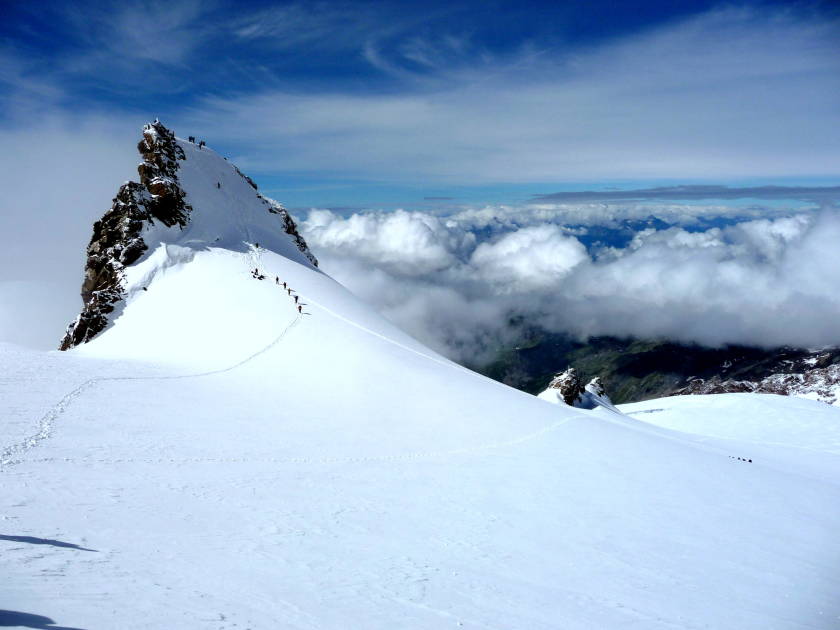
You can also use one mountain hut as your base camp and summit multiple peaks. From Mantova Hut you can scale Vincent Pyramid (4215m) one day, and the iconic Punta Gnifetti (4554m), which will see you traversing glaciers and navigating rocky ridges. Experienced hikers only!
Read more: The Guide to Climbing Monte Rosa
2. Peaks of the Balkans, Albania, Kosovo, Montenegro and North Macedonia

- Start/Finish: Radomire/Valbona Valley
- Distance: 42.8km (69km)
- Duration: 5-6 days
- Difficulty: Challenging
- Best for: Exploring the wild peaks of the Balkans
An absolute humdinger of a route, which takes you up three summits and four countries in the Balkans. You'll start off by climbing Mount Korab (2764m), a summit shared by Albania and Macedonia. The day begins in the verdant valleys of Albania, and a strenuous but non technical climb through verdant pastures. Once descending, you'll drive to Europe's youngest country, Kosovo.

The next day you'll climb its highest peak, Gjeravica (2656m), passing boulder fields and a heart-shaped glacier lake to the imposing summit. Descend via an old Yugoslav border patrol route, and spend the night in a shepherd's hut. From there you'll hike through the green pastures and old growth forests of the Eastern Alps to the Montenegro border. Your final summit, the next day, is the craggy Zla Kolata (2534m), Montenegro's highest peak.
You'll be trekking for long days, up steep passes. But you'll also have the opportunity to experience mountain trekking in one of Europe's most underrated regions.
3. The Vindios Loop in the Picos de Europa, Spain

- Start/Finish: Posada de Valdeón
- Distance: 35.6 miles (57.2km)
- Duration: 4 days
- Difficulty: Challenging
- Best for: An under-the-radar hiking challenge
The Picos de Europa National Park straddles three provinces of northern Spain, and consists of green foothills, forests that are home to the brown bear and the Iberian wolf. The craggy jewel in its crown are the jagged limestone peaks of the Picos de Europa, many of which you will summit on this trekking circuit, which takes you hut to hut in the Picos de Europa.
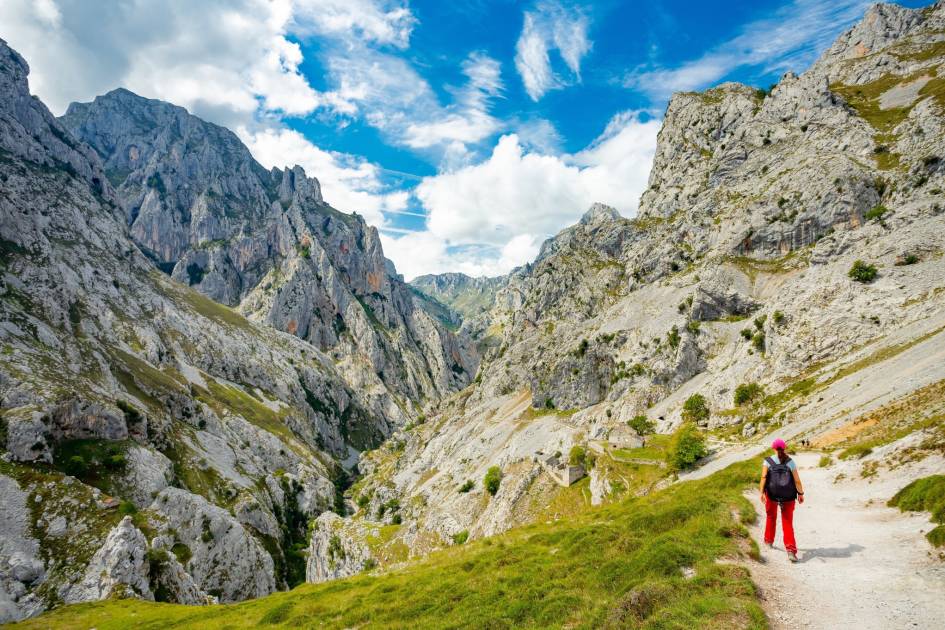
The Vindios Loop begins from the picturesque village of Posada de Valdeón, taking you along the Chemin du Cares and up onto the Pico de Europa massif. You'll trek from hut to hut, with brilliant views over the rocky peaks.
Read more: Spain's Best Kept Secret: Hiking in the Picos de Europa
4. The Madeira Coast to Coast Trek, Portugal

- Start/Finish: Machico Bay/Seixal Beach
- Distance: 46.9 miles (75.5km)
- Duration: 4-5 days
- Difficulty: Challenging
- Best for: Island lovers
If you want an island traverse that's easier than Corsica's iconic GR20 hike, whilst serving up equally beautiful views, then consider hiking the lesser-known trails across Madeira. There are plenty of wonderful day hikes which can be linked together to create a coast to coast traverse.
Starting at Machico Bay, you’ll follow a quiet trail along Madeira's traditional irrigation channels (levadas) and zig zag across vertical cliffs to Porto da Cruz for views of ocean, dense forest, wildflowers and mountains. The next day is a tramp through Madeira's UNESCO-designated laurel forest.

The day after will see you hike Madeira's PR1 Route, a trek island's three highest peaks – Pico do Arieiro (1817m), Pico das Torres (1851m) and Pico Ruivo (1862m). After that it's a steep descent from the highlands to Madeira's unspoilt northern coast to Seixal Beach, a dramatic beach of black volcanic sand and thundering waterfalls.
Read more: The Best Hikes in Madeira
5. Tour de Mont Blanc, France

- Start/Finish: Bellevue/Tré-le-Champ
- Distance: 105.6 miles (170km)
- Duration: 9- 11 days
- Difficulty: Challenging
- Best for: Classic Alpine views, no mountaineering experience needed
This mother of all treks is one of the best hikes in France, circumnavigating the mighty slopes of the highest mountain in the Alps: Mont Blanc. Trekking the Tour du Mont Blanc (TMB) introduces the ambitious trekker to some of the most dramatic and versatile scenery in the world. It's one of the most famous hiking tours in Europe, up there with the likes of the Camino de Santiago, and one of the best European walking holidays. With its 170 kilometres, it is certainly a long-distance trek - and you'll be walking on high mountain trails with a lot of elevation gain (around 10,600m/35,000ft) over the course of the 11-day hike.
If you're feeling particularly intrepid, you could climb Mont Blanc as an alternative. You’ll need to be proficient in use of crampons and an ice axe to make your way over rock and ice, and you’ll need an experienced guide.

Read more: The Beginner's Guide to Trekking the Tour du Mont Blanc
6. The Selvaggio Blu Trail, Sardinia

- Start/Finish: Santa Maria Navarrese/Cala Sisine
- Distance: 24.8 miles (40km)
- Duration: 4-5 days
- Difficulty: Tough
- Best for: A coastal obstacle course
It's renowned for being Italy's toughest trek, but it takes place on the sleepy sun-kissed island of Sardinia. The Selvaggio Blu trail is an epic 40 kilometre route that includes 4200m of vertical gain, five abseils and two via ferratas. You'll hike across rock arches, narrow chasms and through forests.
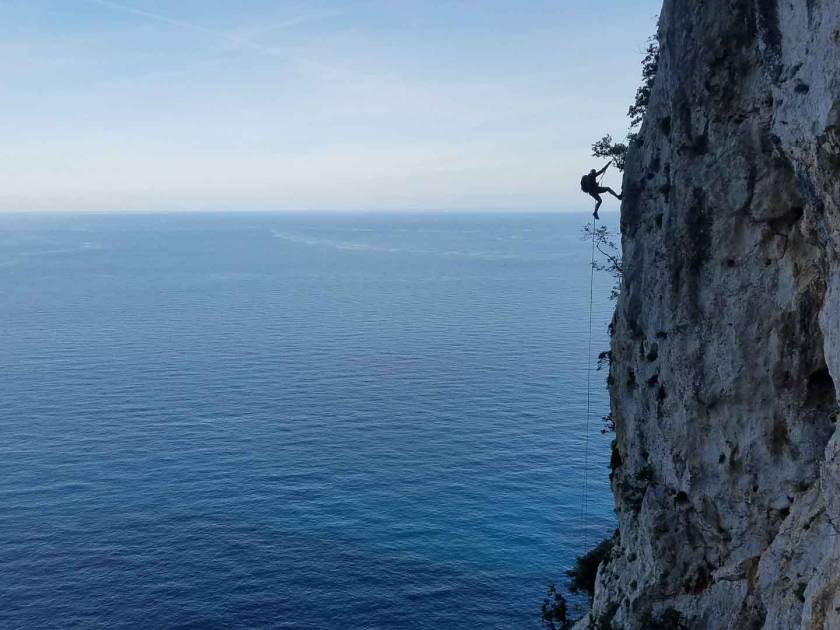
However, it is possible to steer clear or bypass some of these more challenging scrambles, as the Selvaggio Blu has several slightly easier variations - a guide (at the very least an accurate map) is highly recommended to navigate it. Alongside these tough scrambles and climbs, you can relax with a swim at some of the most beautiful beaches in Sardinia.
Read more: our guide to the Selvaggio Blu trail
7. Mount Triglav, Slovenia

- Start/Finish: Krma Valley/ Kredarica Hut
- Distance: 11.8 miles (19km)
- Level: Challenging
- Difficulty: Challenging
- Best for: An introduction to via ferrata
Climbing Mount Triglav is a rite of passage for Slovenian trekkers, and for mountaineers visiting this country. There are two ways to access the 2864m summit, both challenging and both relying on via ferrata routes or fixed cables to help climbers through the scree and along narrow paths.
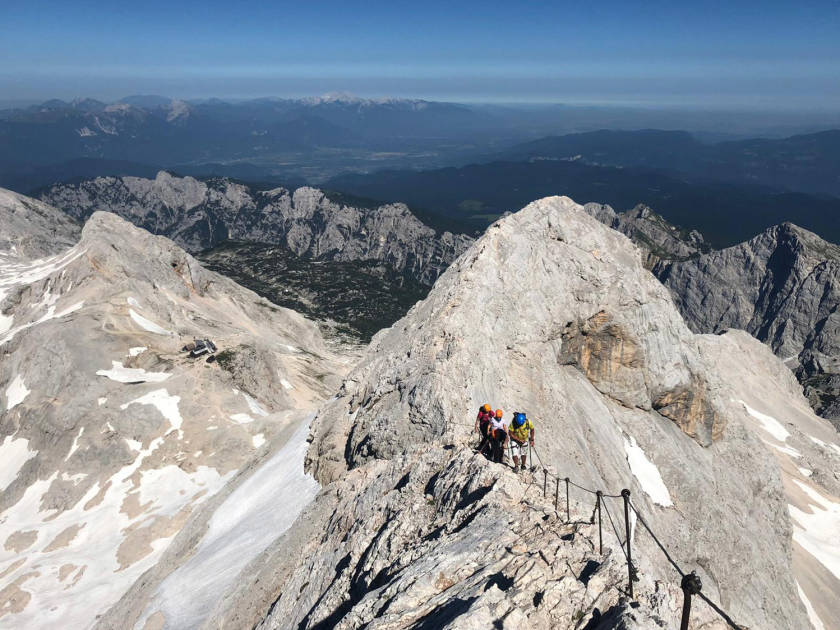
You'll start off hiking through the verdant Krma Valley, before ascending up through the pine forest to a high plateau and on to Kredarica hut. Summit day is an 8-9 hour trek up a rocky path and up 400m of via ferrata. Because of this, only very experienced mountaineers should summit Triglav without a guide. There are plenty of other amazing hikes in Slovenia, too.
Read more: 5 Great Routes up Mount Triglav
8. The Transcaucasian Trail (Upper Svaneti Section), Georgia

- Start/Finish: Chuberi/Ushguli
- Distance: 80.7 miles (130km)
- Duration: 7-10 days
- Difficulty: Challenging
- Best for: Wild peaks and high-altitude passes
When you go hiking in Georgia, you go exploring where few others have before. Georgia’s arid Caucasus Mountains have just opened to tourism in recent years. The Transcaucasian Trail is a new initiative - the creation of a 3,000km trail following the Greater and Lesser Caucasus Mountains and connecting 24 national parks and reserves in the region, which is one of the most biologically, culturally and linguistically diverse areas in the world.
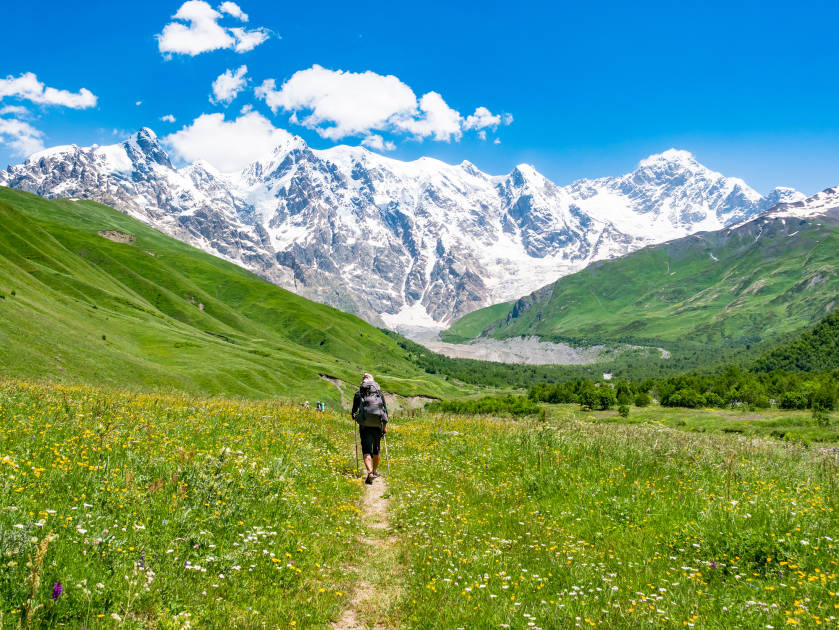
The entire trail isn't complete yet, but sections can be hiked. We recommend the section through Georgia's Upper Svaneti region, an intrepid 10-day adventure. It takes you across five major mountain passes, and through rapidly changing landscapes, from deep forests to the jagged glacial peaks of the Caucasus. You’ll spot wildlife like deer, chamois and marmots on your way.
There are plenty of other hikes in Georgia, if you're interested in exploring this underrated hiking destinations. The country's third highest peak, Mount Kazbek (5054m), can be climbed too.
Read more: 5 of the Best Hikes in Georgia
9. The West Highland Way, Scotland

- Start/Finish: Milngavie/ Fort William
- Distance: 95 miles (152.8km)
- Duration: 5-10 days
- Difficulty: Moderate
- Best for: Exploring the Scottish Highlands
The West Highland Way is one of the most iconic multi-day hikes in the world. It'd be fair to say the same about the Scottish Highlands in general, as one of the globe's favourite walking destinations.

The West Highland Way route has everything you need. Leaving from Milngavie, a small town near Glasgow, you head 95 miles north to Fort William - next to Ben Nevis, the highest mountain in the UK. Along the way you'll walk on the bonnie, bonnie banks of Loch Lomond and climb Conic Hill for beautiful views over the loch. You'll walk through Glencoe, past the famous form of Buachaille Etive Mor, through the Rannoch Moor and eventually reach Glen Nevis and Fort William.
There are options for hotels, mountain huts or cabins to stay in along the way, although many people choose to camp. This is the oldest hiking trail in the UK and is one of the best treks in Europe for beginners.
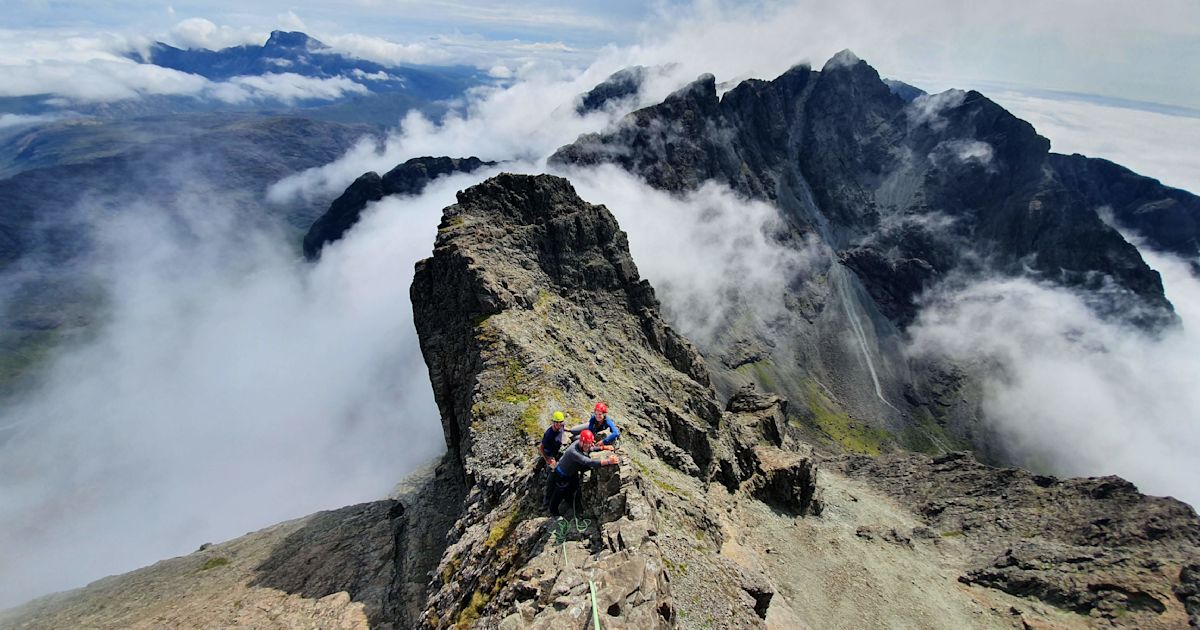
10. Gran Canaria Traverse, Spain

- Start/Finish: Barranco de Guayadeque/Agaete
- Distance: 42.8 miles (69km)
- Duration: 5-6 days
- Difficulty: Challenging
- Best for: Crossing a 'continent in miniature'
The Canary Islands are well known for being a winter sun destination, and for resort tourism. But they are also fantastic year-round hiking destinations, with quiet trails crossing their unspoilt interiors. Gran Canaria is known as a 'continent in miniature', due to the diversity of its landscapes and microclimates. There are plenty of routes across it, many running through its barrancos (or gorges).
Our favourite option is to begin your trek inland, in the Barranco de Guayadeque - a gorge inhabited by pre-Hispanic Canarians in intriguing cave houses. You'll pass through pine forest and ascend to the summit of El Pico de Las Nieves (1950m), the highest mountain in Gran Canaria. The next day you'll cross the rocky highlands to the famous Roque Nublo, an 80-metre monolith which is shrouded in myths and mystery.

From there, you'll pass through cave villages and mountain viewpoints, until you descend through rare subtropical laurisilva forest. From there, you'll slowly descend through the Agaete Valley, the most fertile valley on the island, until you reach the coastal village of Agaete. And yes, it is time to go for a swim and relax now.
While the hike doesn't take place at high altitudes, we've given it a challenging rating because you'll be hiking for up to 10 hours a day, and the heat can make it difficult for some people.
Read more: Hiking the Secret Hinterlands of Gran Canaria
11. The Laugavegur Trek, Iceland

- Start/Finish: Landmannalaugar Campground/Þórsmörk
- Distance: 34.1 miles (55km)
- Duration: 4-5 days
- Difficulty: Challenging
- Best for: Fire and ice
This hiking trail has been rated one of the best in the world by the National Geographic, and it's easy to see why. The Laugavegur trail takes you through rainbow coloured mountains, past hot springs, over glaciers and volcanic slopes.
The trail begins in the colourful, geothermally active Landmannalaugar Nature Reserve. You’ll ascend the black obsidian slopes of Hrafntinnusker and cross the sparse black ash field of Mælifellssandur. From there you’ll pass into Þórsmörk, ‘The Valley of Thor’, a surprisingly green area nestled between three glaciers.

There are a couple of accommodation options along the way. Choose to stay in rustic mountain huts (as you'll do on our hut-to-hut trek along the Laugavegur trail) or you can camp outside them! On our newly launched trekking and camping the Laugavegur trail trip you'll stay in a Simond MAKALU T3 tent with Thermarest mattresses. There are toilet facilities, hot showers (for a small fee) and a communal mess tent for socialising and meal times!
Read more: A Guide to Hiking the Laugavegur Trail
12. Haute Route, France & Switzerland

- Start/Finish: Argentière/Zermatt
- Distance: 85.1 miles (137km)
- Duration: 10-12 days
- Difficulty: Challenging
- Best for: Classic Alpine views
The Haute Route starts at the foot of Mont Blanc, the highest massif in Western Europe, and ends on the flanks of the most famous, if not the most elegant and most instantly recognisable of all mountains, the Matterhorn.

Even though it has made its name for being one of the best winter hikes on skis, the 200km long summer version of this trek is certainly no less interesting or challenging. On this hike, you’ll cross 11 passes, clock up more than 12,000 metres in ascents and pass under ten of the twelve highest peaks in the Alps.
Read more: Everything You Need to Know About the Haute Route
13. Tatranská Magistrala, Slovakia

- Start/Finish: Podbanské /Vel’ké Biely Pleso
- Distance: 26 miles (42km)
- Duration: 2-4 days
- Difficulty: Moderate
- Best for: Exploring the High Tatras
Hike the High Tatras, Eastern Europe’s only alpine mountain range, along the Tatranská Magistrala trail. It takes you through some epic scenery, from spruce forests and stony ridges to glassy lakes. This 42-kilometre trail starts at the remote village of Podbanské in the foothills of the Western Tatras and finishes at the far-more remote lake of Vel’ké Biely Pleso (although many people continue walking to the scenic village of Ždiar).

The path is relatively easy, and mostly stays within the altitudes of 1200m to 1800m. However, there are some 2000m+ peaks you'll be scrambling up, including Sedlo pod Svišt’ovkou (2,023m) and Vel’ka Svit’ovka (2037m). The scree on the paths can be slippery, but there are chains to help support you. Bed down in mountain huts along the trail.
14. The Dolomites' Alta Via II, Italy

- Start/Finish: Plose Gondola Station/ Passo Croce D’Aune
- Distance: 116 miles (187 km)
- Duration: 10-16 days
- Difficulty: Tough
- Best for: Majestic mountains, delicious pasta
The spiky peaks, crags and pinnacles of the Dolomites are a UNESCO World Heritage site for multiple reasons. There’s history, where trails are named after WWI, passing abandoned bunkers along the way. There’s culture: visit the Ladin shepherds in their once isolated villages. There’s also diversity in beauty and language. Traverse pastel meadows of wildflowers and hear the whispers of different languages inhabiting the Italian Alps.
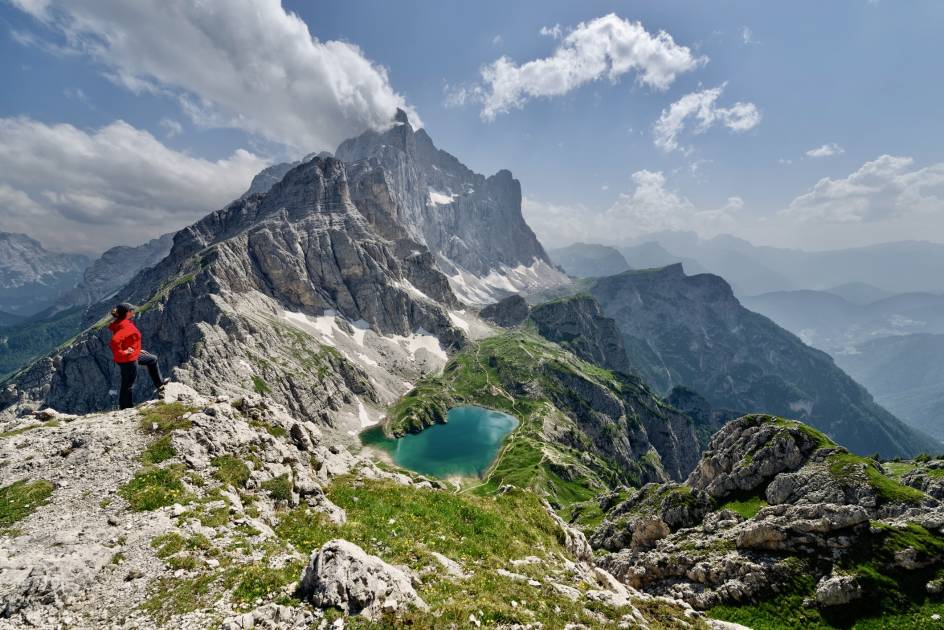
There are plenty of hikes through this glorious region of Italy too. Alta Via I and Alta Via II are two of the best long distance routes. Alta Via II is the harder and less crowded of the two, and takes you from Bressanone to Feltra across the Sella Massif and through the heart of the Dolomites. You'll be scrambling up exposed limestone peaks and crossing high passes, whilst accompanied by spectacular views of these jutted mountains.
You can also hike a mixture of the Alta Via I and II, selecting the most picturesque parts of each route. This includes the Van de Zita with its high-altitude valleys and rock spires, and the majestic Cinque Torri rock formations, which are surrounded by alpine meadows. Bunk down in cosy mountain huts and enjoy rustic Italian fare after a long day's hike.
Read more: 5 of the Best Hikes in the Dolomites
15. The Albanian Coastal Trail, Albania

- Start/Finish: Llogara Pass/Borsh Beach
- Distance: 34.7 miles (56km)
- Duration: 3-5 days
- Difficulty: Moderate
- Best for: Beaches, mountains and little explored trails
This glorious coastal trail takes you along the spine of the Karaburun Peninsula, climbing to the high point of rocky Mount Gjipali (1,446 metres). It passes through pine forests and fragrant macchia along rarely used shepherds' tracks, dropping down to deserted beaches. You'll experience an astonishing diversity of landscapes.
You'll pass through quiet mountain villages and relaxed coastal towns, fuelling up on delicious Mediterranean meals and refreshing yourself with dips in the brilliantly blue ocean.
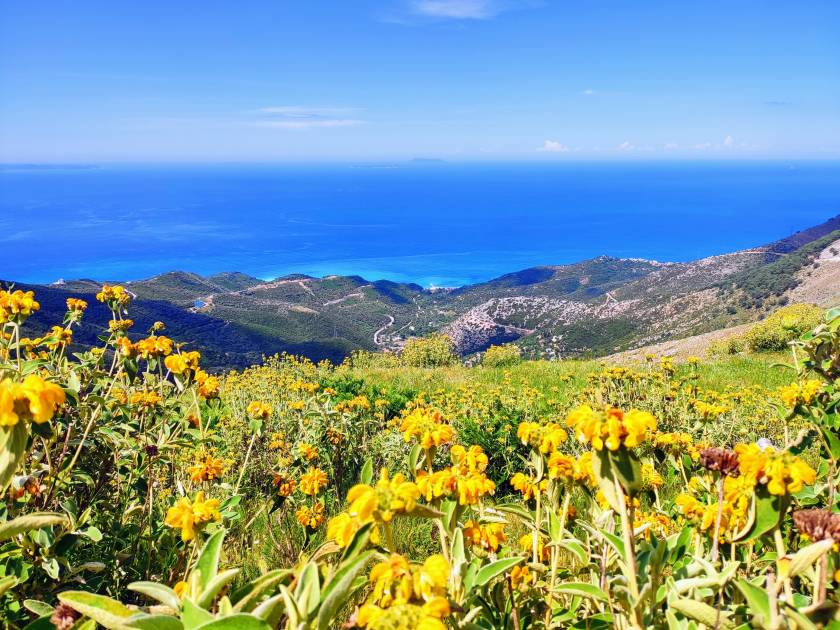
Read more: Why Off-Season is the Ideal Time to Discover Albania
16. Gran Paradiso Hut to Hut Trail, Italy

- Start/Finish: Pravieux/Surrier
- Distance: 34.7 miles (56km)
- Duration: 3-4 days
- Difficulty: Challenging
- Best for: A quieter alternative to the Dolomites
The Gran Paradiso sits in the Valle d’Aosta, in northwestern Italy’s Alps. Originally this park was set to preserve the Ibex, and the focus on flora and fauna is still one of the main draws of this sprawling park. Its superb hiking is another - there are some excellent short hikes and multi-day epics through the park.
Start in the mountain village of Pravieux, hiking up the eastern side of the valley to Rifugio Tetras Lyre (1996m). As you climb, you'll have views of glaciers and mountains, including the north face of Gran Paradiso peak (4061m). Next up is a day of high alpine pastures and the stunning lakes of Col Nivolet Plateau. Then it's onto Col Rosset (3024m), one of the highest walkable passes in the Alps.
The final day's walk passes Goletta Lake, at the foot of the Goletta Glacier. You'll continue with a steady ascent to Col Bassac Derè – the highest point of the trek at 3082m – and enjoy some of the wildest scenery so far, with imposing peaks and glaciers. The trek ends at the small hamlet of Surrier - you'll be tired after three full days of hiking.

17. The Kungsleden (King's Trail), Sweden

- Start/Finish: Hemavan/Abisko
- Distance: 292 miles (470km)
- Duration: 25-35 days
- Difficulty: Moderate
- Best for: An introduction to Arctic hiking
The Kungsleden is Sweden's most famous hiking trail, for good reason. Located above the Arctic Circle, it's a 470-kilometre trail that takes you through the green valleys, wide vistas and high peaks of the Abisko region. You'll pass the snowy mountains and spruce forests of the Laponia UNESCO world heritage site, through four national parks and through some of the wildest landscapes of Sweden.
Despite the length of the trail, it's very accessible as it travels through low altitude terrain along clear trails (and of course you don't have to walk the whole route). There are plenty of huts along the way to rest your head, or you can try out camping and roaming free in this Arctic playground.
18. The Matterhorn Circuit Trek, Switzerland

- Start/Finish: Zermatt
- Distance: 93.2 miles (150km)
- Duration: 6-10 days
- Difficulty: Challenging
- Best for: The ultimate hut to hut trekking in Europe experience
The Matterhorn Trek has been described as one of the most beautiful treks in the world, taking in many ancient trails that have linked the Swiss Alps and Italian valleys for centuries. The 150km route offers a multicultural experience, crossing from the pristine surroundings of Switzerland to Italy through the Matterhorn Valley, and staying in remote mountain huts en route.
You'll trek across Alpine meadows and up high passes, surrounded by mountains and glaciers on either side. One of the hike's most iconic views is the pyramid-shaped Matterhorn reflected in the mirror-like waters of Stellisee Lake.
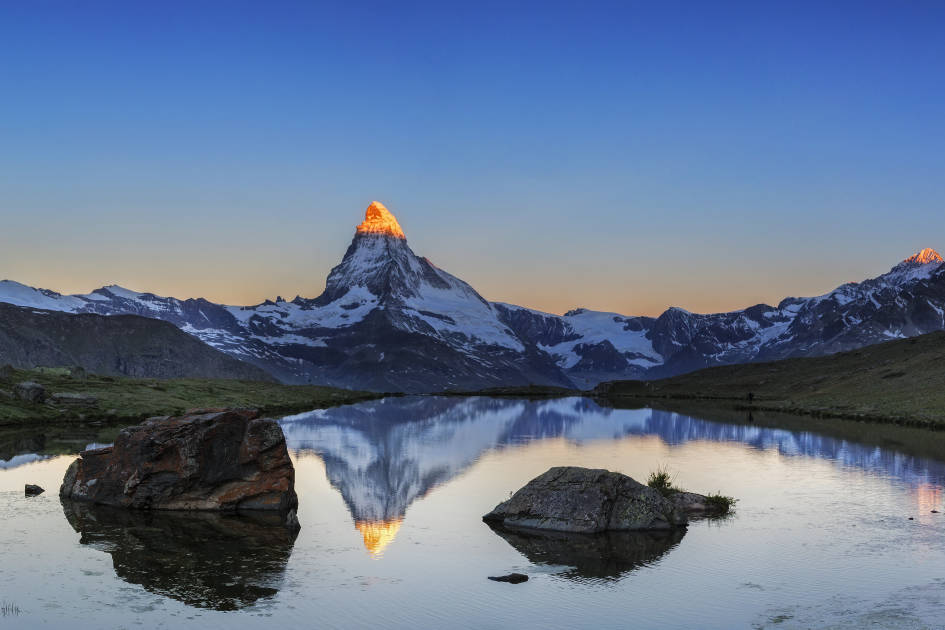
If you have limited time, you can always hike a mini version of the Matterhorn trek, which incorporates some of the most picturesque parts of the route with some challenging ascents such as Mount Pfulwe (3313m).
19. Vikos Gorge and Beyond, Greece

- Start/Finish: Vradeto/Bridge of Aristi
- Distance: 11 miles (18km)
- Duration: 2 days
- Difficulty: Moderate
- Best for: Exploring Greece's remote corners
Vikos Aoos National Park, in northwest Greece, is a natural playground of deep gorges, green valleys, verdant forests and fast-flowing rivers. One of the most popular day hikes in the park takes you through Vikos Gorge, the deepest gorge in the world. But you can continue hiking along the park's trails for a glorious multi-day hike.
Begin in the Zagori region, renowned for its 46 traditional stone villages (zagorohoria) surrounded by the Pindos Mountains and connected by ancient walking trails. Start in the village of Vradeto and hike to Kapesovo via the famous Vradeto steps (an ornate construction of 1200 stone steps and 39 turns). You'll pass through several villages before crossing over the Bridge of Misios.
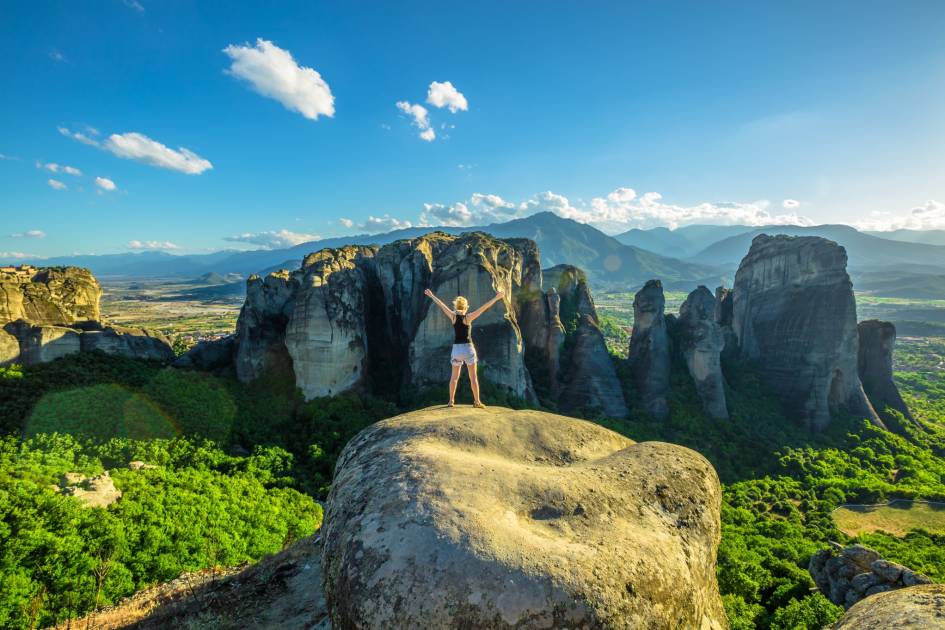
Day two will take you through the Vikos Gorge, renowned for its biodiversity and its steep stone walls. You'll follow a tributary of the Viodomatis River to exit the gorge.
20. The Camiño de Mar, Spain

- Start/Finish: Ribadeo/Ferrol
- Distance: 170 miles (275km)
- Duration: 12 days
- Difficulty: Moderate
- Best for: A quieter coastal variant of the famous Camino
The Camino de Santiago is a network of hiking trails following ancient pilgrim routes towards the Spanish city of Santiago de Compostela. The Camino del Mar is a variant of the Northern Way that traces the coastline from the Basque Country, across the remote Galician-Cantabrian coast. It's far quieter than other stretches of the Camino, taking you along rugged clifftops, past quiet beaches and through unspoilt villages. At Ferrol, you'll join up with the English Way, where you can head inland to Santiago.
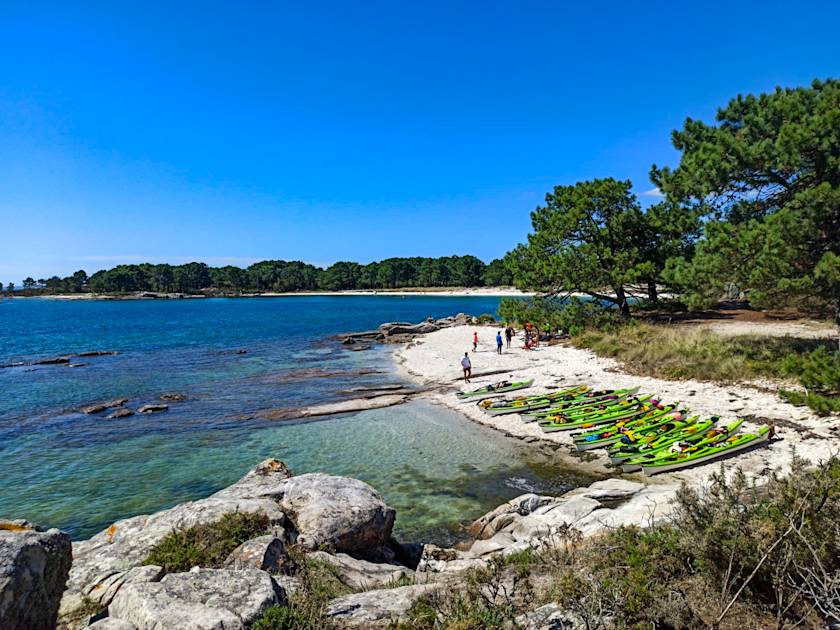
Considering this hike runs along the coastline, it's also possible to kayak this stretch of Camino, experiencing it in a unique way.
When is the Best Time to Hike in Europe?

The best time to hike in Europe differs according to region and elevation. Summer (June to September) is the best time for high-altitude hiking such as trails in the Alps, Dolomites and Pyrenees, as the conditions are most stable and huts and guesthouses will be open. This is also a good time for hiking in northern Europe, in destinations such as Scandinavia and the Scottish Highlands. However, you might find the temperatures too hot for hiking in areas such as southern Spain and Greece.
Spring (April to June) will see fewer tourists and cooler temperatures than summer. With long daylight hours and the trees and flowers beginning to bud and bloom, it’s one of our favourite times to go hiking in Europe. We particularly recommend the Mediterranean regions during this time of year.
Autumn (September to November) brings cooler temperatures and the blaze of autumn foliage. This is an ideal time to hike the forests and hills of Europe, such as Romania’s Carpathian Mountains or Slovakia’s High Tatras. Meanwhile, southern Europe will have cooled down after a hot summer, and makes for pleasant hiking weather.
Winter (December to March) offers exciting opportunities for hiking in the snow - you might need snowshoes or crampons to do this. However, some mountain trails might be closed during this season. However, there are some winter sun destinations in Europe, such as Gran Canaria, where the weather is mild enough to hike.
What Animals Live in Europe?

Europe is home to a wide array of wildlife thanks to its diversity of habitats, from the volcanic peaks of Iceland to the endangered laurisilva forest of Madeira. In areas of Scandinavia and Eastern Europe (such as the Carpathians) you’ll find brown bears and Eurasian lynx.
In the Alps you’ll find chamois, Eurasian ibex and wild boar; in Iceland you might see Arctic foxes, ravens or Arctic terns. Meanwhile, Madeira is a marine and birdlife haven - the waters are home to bottlenose dolphins, pilot whales and sperm whales, while endemic bird species include the Madeira firecrest and Zeno’s petrel.
Where to Stay in Europe?

When hiking in Europe, there are numerous accommodation options available, ranging from wild camping to high end hotels. We particularly enjoy hut to hut trekking, where you can stay in mountain huts and refuges on multi day hikes. In general, they tend to provide dormitory accommodation, rustic but filling meals, and a communal lounge where you can meet other hikers.
What to Eat in Europe?

Each country in Europe has its own distinctive culinary traditions and dishes. Italy, for example, is renowned for both its pizza and pasta dishes. France is known for its delicious pastries - a simple butter croissant is an excellent breakfast while hiking. Stay in the mountain huts in the Alps and you’ll be treated to carb-heavy dishes such as tartiflette (potatoes and bacon with melted Reblochon cheese), melted cheese fondue or spaetzle - German noodle dumplings.
Travel to Greece and you’ll be able to sample an array of hot and cold mezze, including dolmades (stuffed vine leaves), meatballs, feta dip and olives. If you head to Georgia, make sure to try their national dish, khachapuri; cheesy bread with a runny egg in the centre.
How to Get to (and Around) Europe?

By train: Europe has an excellent train network, allowing you to travel between and around countries. Eurostar offers high-speed trains from London to Paris, Brussels, Amsterdam, and other European cities via the Channel Tunnel. Each country has its own rail service, including SNCF in France, Deutsche Bahn in Germany, and Trenitalia in Italy.
By plane: There are numerous international and domestic airports across Europe. Major international airports include London Heathrow (LHR), Paris Charles de Gaulle (CDG), Frankfurt (FRA), Amsterdam Schiphol (AMS), and Madrid Barajas (MAD), where flights are scheduled around the globe.
By bus: There are plenty of local, intercity and cross-country bus services in Europe. Check out FlixBus to plan and book long distance coach travel.
Inspired? For even more ideas, check out our Hiking Adventures collection.




